1618
Tu-114 inside and outside
Writes blogger russos:
this plane must do a separate post. Firstly, it is large, and secondly, it made an incredible impression on me. And third, it's a plane to the soul. I can not explain it, but when I got to the room, I just felt it.
But first the bad news. Summer 2006. Then various aviasaytah was reported that the "East Line" wants to destroy the plane TU-114 monument to Soviet-76464, which stands on a pedestal near the airport Domodedovo to arrange parking. On the staff of indignant letters "East Line" answered that this can not be, and they do not want to destroy the plane. As it turned out - I lied.
A copy of the Tu-114 Soviet-76464 (serial number 98413), standing on a pedestal at the entrance to the airport Domodedovo c 1976, was brutally destroyed by the company "East Line" in the reconstruction of the airport 2 August 2006 For what they are forever cursed.
30 photos
1. Tu-114 Soviet-L5611, first flew on 15 November 1957. Unlike the Tu-95, Tu-114 was designed as nizkoplan, forcing designers to significantly increase the height of the landing gear (near the front you can find a support person for scale), whereby it has become much higher than the other civilian aircraft. It later added problems in the operation of the ship. But he is very handsome.

And we are with you, let's fast forward to the Monino, which houses the first flying prototype of the Tu-114 Soviet-L5611. Traditionally, the first a brief historical background.
-
In March 1955 the government had issued the task of designing a long-haul passenger aircraft. For large hops needed it was not just a powerful, economical and roomy, but quite reliable liner with exhaust systems, engines and airframes. Moreover, the government needed to create long-range passenger aircraft as soon as possible, do not allow for much testing and improvements.
As always, the pioneers began to Tupolev. Already having experience in remaking the military to a civilian aircraft (TU-16 - Tu-104), Tupolev immediately chose a prototype of the new machine - well-proven bomber Tu-95.
Tu-114 made very quickly - in just two years. The lead designer was his N.I.Bazenkov. November 15, 1957 test pilot A.P.Yakimov first raised the Tu-114 in the air, and began flight tests.
Despite the huge amount of tests verified the design allowed the foundations to quickly organize "the bride" of the aircraft. The first demonstration flight to New York by plane number L-5611 made in 1958 (and, in the stunned New York, there was not a suitable ramp or a tractor), and May 19, 1959 the crew A.P.Yakimova, MA A.Nyuhtikova, I.K.Vedernikova involving K.P.Sapelkina made its first demonstration flight to Khabarovsk with passengers on board. The flight was a non-profit: the passengers were, along with journalists, mainly aviation specialists.
The reliability of the aircraft was so high that in 1959 it was also carried out an unprecedented campaign, which has no analogues in the history of aviation: on the plane, performance tests have not yet been completed, the government moved the USSR, headed by Nikita Khrushchev to Washington .
The first scheduled passenger flight to Khabarovsk was performed from Vnukovo April 24, 1961. A special place in the history of this aircraft take flights to Cuba. But since 1967, began joint operation of aircrafts on the route from Moscow to Tokyo together with airline "Jal". Flight jointly served the Japanese and Soviet flight attendants, received special training. Aircraft (was converted two-car) has an outer symbolism as "Aeroflot" and "Jal».
After the international route IL-62, Tu-114 lost its flagship status of "Aeroflot", all of the park was transferred from Sheremetyevo to Domodedovo. There they are in the 220-seat version of regular flights to Almaty, Tashkent, Novosibirsk and Khabarovsk, where there were long strips. The plane behaved as reliable as in the 1960s. Nicknamed "The Dragon" (Novosibirsk) or "Shaitan Arba" (Alma-Ata) were purely humorous, but not mocking. Occasionally there were cases of engine failure, is not leading to any serious consequences. There was the case of an emergency landing with a faulty landing gear at Domodedovo, too, ended happily. However, after the operating time by the majority of cars flying no more than 15 000 hours (there were cracks in the power panel engine modifications and repairs have decided not to do) all the Tu-114 in November 1976 were taken out of service and decommissioned no later than the summer of 1977. Once the machine was cut 21 (all were released 31), and a few cars continued to use the Air Force of the Soviet Union until 1991.
2. Equipped with four turboprop NK-12MV with two coaxial counter-rotating propellers AV-60 on each. The total power of the engines on takeoff mode is 60 thousand hp. Hourly fuel consumption at no more than 5600 kg (in the first hour of flight), which by today's standards for aircraft of this size is very economical.

3. During the operation was lost two cars. Nearly new board broke in half in the parking lot at Vnukovo due to an error the flight engineer, who started to clean the chassis with crimped racks. A single accident occurred February 17, 1966 in Sheremetyevo because making a wrong decision to make off in bad weather at night with the snow is not cleared to the full width of the runway.

Typically Soviet disaster. The plane was flying to Brazzaville (Congo), to Africa, where it was planned to carry the delegation to the acceptance of the airfield. Weather was not favorable for a few days - a blizzard drifts Sheremetyevskaya band visibility due to fog, we find the waves, was extremely limited. However, political ambition and a desire to save the honor of the big bosses of the uniform industry led to the dismissal of the commander of the ship V.A.Filonova decision to take off, and thus contributed to the accident.
The strip was cleared, but not across the entire width, and 40 meters. As a result of snow blowers on the edges of the runway formed snowy parapets, severely hampered the visibility of lights from the cockpit. Thus, the pilot could withstand the run-up direction (and was carried off at night) almost exclusively for the course unit. V.A.Filonov to direct a running start could not have known, and even assume.
After the start of the takeoff when it became clear that the runway lights are hardly visible (light up), rejected take-off was too late. V.A.Filonov masterful direction of sustained strictly on the runway by only one arrow navigation device - as subsequent measurements, the deviation was not more than a degree that is just at the limit of the pilot. And only at the end of the takeoff poor preparation band still played a fateful role - left truck chassis already divorced touched on one of the parapets of snow, which caused a strong throw to the left from the sinking aircraft nose. The pilot, fending off, given the right bank screws the third and fourth engine was hit on the cover strip and collided with the ground, leading to the complete destruction of ... killing many passengers and crew members, including the captain. Some lucky enough to survive for one reason or another, particularly at the tail of the aircraft.
4. It was the aircraft with three classes of layout: economy class (ordinary chair of 3 + 3), first class (rows of seats separated by a table with a table lamp) and finally, with four compartments - these compartments as the train, but by 3 bedrooms space. Plane tickets cost the classes, although with a slight difference.

5. If the original aircraft was calculated for 120 passengers, then followed in 1960-1970-ies Shaft traffic exceeded all conceivable projections, long consigned to oblivion on our domestic routes any arrangement other than economy class. The maximum capacity of the Tu-114 reached 224 seats. It was at that time the most spacious airliner "Aeroflot".
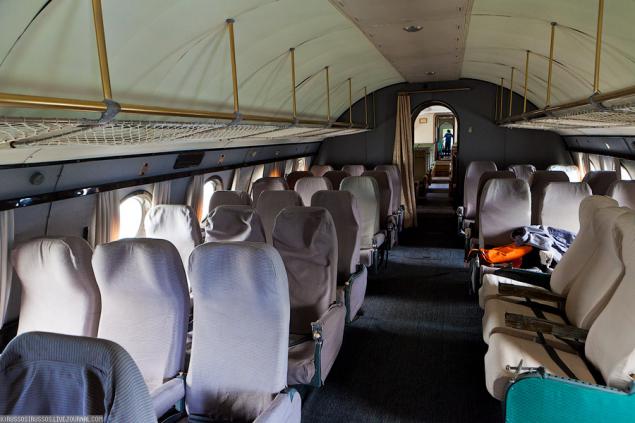
6. First class. The upholstery of chairs, tables and other furniture were restored by volunteers in the museum. If you look closely, it is visible on the aisle step on the floor (there goes the center section), which does not add comfort for flight attendants.

7. aircraft in very bright and very unusual in layout to the current time.

8. Two deck scheme (layout of the fuselage: the bottom - kitchen, baggage and cargo and crew rest room, at the top - the crew and passengers), which became the core of modern Airbus in the design, was introduced on the Tu-114. Curiously, that was connected to the kitchen cupboard lift, as IL-86. The staffing of the crew of the first half of the 60s was the cook.
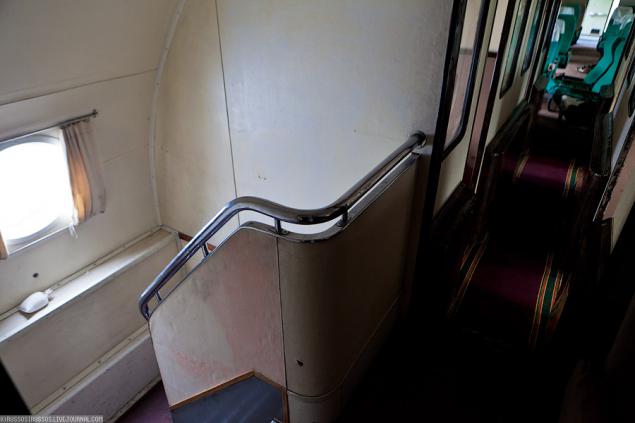
9. Cabin first Tu-114 was carried out without the influence of interior compartment cars of long-distance trains and ocean liners sea. Therefore comfort on the Tu-114 seemed an ordinary Soviet citizen of the time (not spoiled facilities) also somehow extraordinary.

10. One of the compartments. As they say, there were three beds - with two transverse and one longitudinal flanges. Honestly, I do not really understand how they're arranged.

11. The passengers of the Tu-114, after sitting in the compartment at a table near the window of the first hour of the flight, got down pillows, blankets and sheets, and went to bed.
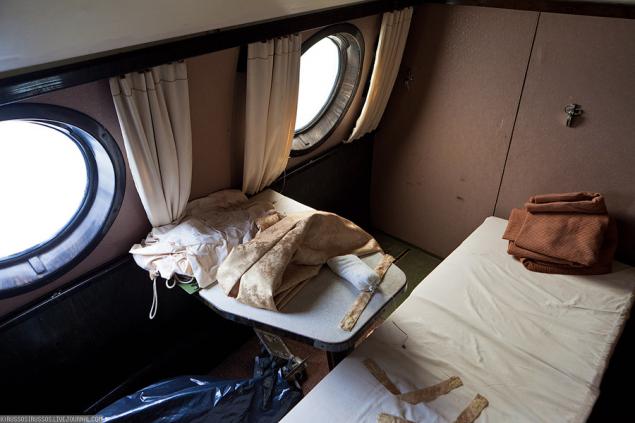
12. In general, I had a feeling that I am, rather, on an ocean liner than a plane.
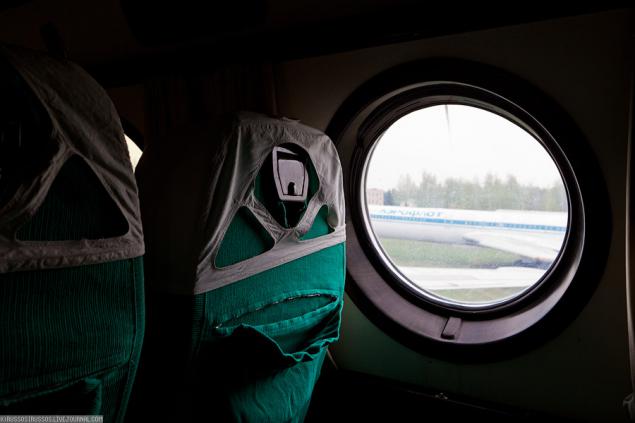
13. Shop economy class.
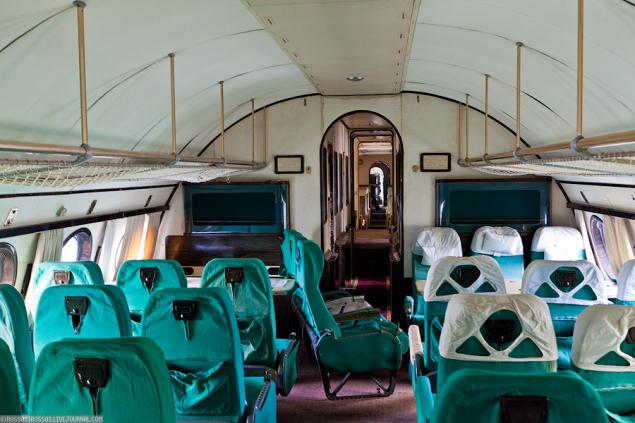
14. Install seats in the renovated interior. The restoration works lasted two years

15. In the 1970s, developed a modification of the Tu-114A, which, according to V.G.Deloveri, "provided a significant improvement in flight performance of the machine by changing the profile and the mechanization of the wing." Unfortunately, the project Tu-114A and was not implemented. Also found the use of a number of modifications and improvements, which were identified - they had no interest. Those innovations are still there - it had been agreed with great difficulty.

16. In the field of passenger comfort, the impression of the Tu-114 spoiled rich low-frequency noise, which was particularly strong in the area of the screws in the first-class cabin. In the opinion of some experienced passengers, he allegedly tolerated a little easier than the IL-18, because it was not as penetrating. Again, after the piston aircraft such things seemed trifling. Tu-114 began to lose his "image" in the eyes of passengers only with the advent of long-distance routes to low noise IL-62, when it was nothing to compare.

17. With very strong (steel spars!) And yet flexible structure (oscillation amplitude of the wing plus or minus 2 meters for the ending), Tu-114 perfectly tolerated even by strong turbulence. It was an indispensable quality when flying over the ocean during tropical storms and cyclones, or when crossing mountain ranges like the Himalayas.

18. Now go to the cabin liner.

19. The workplace flight engineer. It is surprising the door to the cockpit, which is more appropriate on a ship at sea than in the air.

20. Place the FAC. At the bottom - pass into the workplace navigator.

21.Shturval copilot.
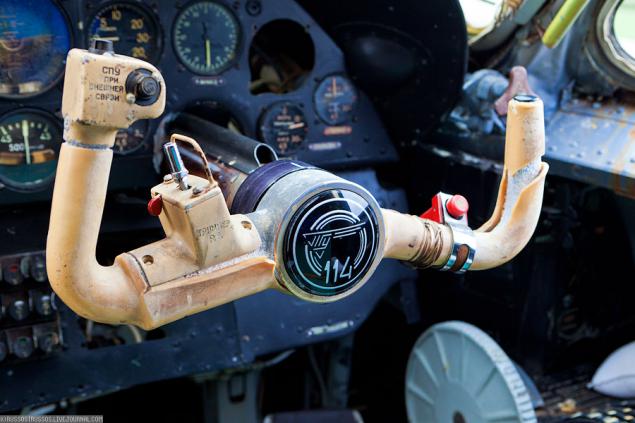
22. Lights.

23. Often, the military navigators trained in flying on the Tu-114 for precise navigation is the pilots of "Aeroflot".

24. In my view, employment is very austere, it would not hurt to perform ultra-long hours of flights both on the ground and above the oceans.
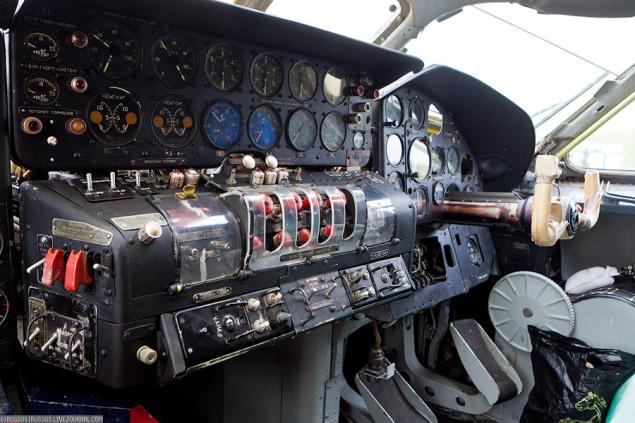
25. The power available at a total engine power of 60,000 hp It was sufficient to secure the continuation of rise in standard conditions with maximum takeoff weight of 173, 5 tons with one failed engine speed after the decision. Anyway, when reduction in Domodedovo at D.I.Kuharenko the fault of a flight engineer with one failed engine was accidentally switched off the second on the same polukryle, the power of the other two and, of course, a brave commander composure was enough to safely plant seemed I would be hopeless machine. H.N.Tshovrebovu once had to distill the Tu-114 on three engines from Delhi over the Himalayas ...!
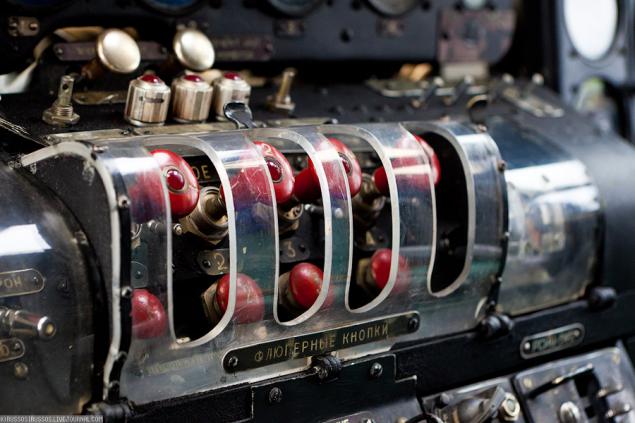
26. A bunch of toggle switches and pokazometrov.

27. Lockout generators. If necessary, one flight engineer movement disconnected all eight generators.

28. Helm FAC.

29. Part of the navigator's equipment.

Tu-114 left in lёtnom condition, no. Preserved four flightless instance Tu-114:
- In the Central Museum of the Air Forces in Monino near Moscow it is the very first prototype plane USSR-L5611 (1 car);
- In the Ulyanovsk Museum of Civil Aviation 2 machines: 1 Tu-114 Soviet-76490 (serial number 64M471) and 1 Tu-116 Soviet-76462 (serial number 7802);
- At the airport Aviation College in the city of Krivoy Rog (Ukraine) is in possession of the Tu-114 Soviet-76485 (serial number 63M461), which will be installed in the aviation museum in Gostomel (Ukraine).
30. Dear visitors of the museum, take care of the exhibits!

Source:
this plane must do a separate post. Firstly, it is large, and secondly, it made an incredible impression on me. And third, it's a plane to the soul. I can not explain it, but when I got to the room, I just felt it.
But first the bad news. Summer 2006. Then various aviasaytah was reported that the "East Line" wants to destroy the plane TU-114 monument to Soviet-76464, which stands on a pedestal near the airport Domodedovo to arrange parking. On the staff of indignant letters "East Line" answered that this can not be, and they do not want to destroy the plane. As it turned out - I lied.
A copy of the Tu-114 Soviet-76464 (serial number 98413), standing on a pedestal at the entrance to the airport Domodedovo c 1976, was brutally destroyed by the company "East Line" in the reconstruction of the airport 2 August 2006 For what they are forever cursed.
30 photos
1. Tu-114 Soviet-L5611, first flew on 15 November 1957. Unlike the Tu-95, Tu-114 was designed as nizkoplan, forcing designers to significantly increase the height of the landing gear (near the front you can find a support person for scale), whereby it has become much higher than the other civilian aircraft. It later added problems in the operation of the ship. But he is very handsome.

And we are with you, let's fast forward to the Monino, which houses the first flying prototype of the Tu-114 Soviet-L5611. Traditionally, the first a brief historical background.
-
In March 1955 the government had issued the task of designing a long-haul passenger aircraft. For large hops needed it was not just a powerful, economical and roomy, but quite reliable liner with exhaust systems, engines and airframes. Moreover, the government needed to create long-range passenger aircraft as soon as possible, do not allow for much testing and improvements.
As always, the pioneers began to Tupolev. Already having experience in remaking the military to a civilian aircraft (TU-16 - Tu-104), Tupolev immediately chose a prototype of the new machine - well-proven bomber Tu-95.
Tu-114 made very quickly - in just two years. The lead designer was his N.I.Bazenkov. November 15, 1957 test pilot A.P.Yakimov first raised the Tu-114 in the air, and began flight tests.
Despite the huge amount of tests verified the design allowed the foundations to quickly organize "the bride" of the aircraft. The first demonstration flight to New York by plane number L-5611 made in 1958 (and, in the stunned New York, there was not a suitable ramp or a tractor), and May 19, 1959 the crew A.P.Yakimova, MA A.Nyuhtikova, I.K.Vedernikova involving K.P.Sapelkina made its first demonstration flight to Khabarovsk with passengers on board. The flight was a non-profit: the passengers were, along with journalists, mainly aviation specialists.
The reliability of the aircraft was so high that in 1959 it was also carried out an unprecedented campaign, which has no analogues in the history of aviation: on the plane, performance tests have not yet been completed, the government moved the USSR, headed by Nikita Khrushchev to Washington .
The first scheduled passenger flight to Khabarovsk was performed from Vnukovo April 24, 1961. A special place in the history of this aircraft take flights to Cuba. But since 1967, began joint operation of aircrafts on the route from Moscow to Tokyo together with airline "Jal". Flight jointly served the Japanese and Soviet flight attendants, received special training. Aircraft (was converted two-car) has an outer symbolism as "Aeroflot" and "Jal».
After the international route IL-62, Tu-114 lost its flagship status of "Aeroflot", all of the park was transferred from Sheremetyevo to Domodedovo. There they are in the 220-seat version of regular flights to Almaty, Tashkent, Novosibirsk and Khabarovsk, where there were long strips. The plane behaved as reliable as in the 1960s. Nicknamed "The Dragon" (Novosibirsk) or "Shaitan Arba" (Alma-Ata) were purely humorous, but not mocking. Occasionally there were cases of engine failure, is not leading to any serious consequences. There was the case of an emergency landing with a faulty landing gear at Domodedovo, too, ended happily. However, after the operating time by the majority of cars flying no more than 15 000 hours (there were cracks in the power panel engine modifications and repairs have decided not to do) all the Tu-114 in November 1976 were taken out of service and decommissioned no later than the summer of 1977. Once the machine was cut 21 (all were released 31), and a few cars continued to use the Air Force of the Soviet Union until 1991.
2. Equipped with four turboprop NK-12MV with two coaxial counter-rotating propellers AV-60 on each. The total power of the engines on takeoff mode is 60 thousand hp. Hourly fuel consumption at no more than 5600 kg (in the first hour of flight), which by today's standards for aircraft of this size is very economical.

3. During the operation was lost two cars. Nearly new board broke in half in the parking lot at Vnukovo due to an error the flight engineer, who started to clean the chassis with crimped racks. A single accident occurred February 17, 1966 in Sheremetyevo because making a wrong decision to make off in bad weather at night with the snow is not cleared to the full width of the runway.

Typically Soviet disaster. The plane was flying to Brazzaville (Congo), to Africa, where it was planned to carry the delegation to the acceptance of the airfield. Weather was not favorable for a few days - a blizzard drifts Sheremetyevskaya band visibility due to fog, we find the waves, was extremely limited. However, political ambition and a desire to save the honor of the big bosses of the uniform industry led to the dismissal of the commander of the ship V.A.Filonova decision to take off, and thus contributed to the accident.
The strip was cleared, but not across the entire width, and 40 meters. As a result of snow blowers on the edges of the runway formed snowy parapets, severely hampered the visibility of lights from the cockpit. Thus, the pilot could withstand the run-up direction (and was carried off at night) almost exclusively for the course unit. V.A.Filonov to direct a running start could not have known, and even assume.
After the start of the takeoff when it became clear that the runway lights are hardly visible (light up), rejected take-off was too late. V.A.Filonov masterful direction of sustained strictly on the runway by only one arrow navigation device - as subsequent measurements, the deviation was not more than a degree that is just at the limit of the pilot. And only at the end of the takeoff poor preparation band still played a fateful role - left truck chassis already divorced touched on one of the parapets of snow, which caused a strong throw to the left from the sinking aircraft nose. The pilot, fending off, given the right bank screws the third and fourth engine was hit on the cover strip and collided with the ground, leading to the complete destruction of ... killing many passengers and crew members, including the captain. Some lucky enough to survive for one reason or another, particularly at the tail of the aircraft.
4. It was the aircraft with three classes of layout: economy class (ordinary chair of 3 + 3), first class (rows of seats separated by a table with a table lamp) and finally, with four compartments - these compartments as the train, but by 3 bedrooms space. Plane tickets cost the classes, although with a slight difference.

5. If the original aircraft was calculated for 120 passengers, then followed in 1960-1970-ies Shaft traffic exceeded all conceivable projections, long consigned to oblivion on our domestic routes any arrangement other than economy class. The maximum capacity of the Tu-114 reached 224 seats. It was at that time the most spacious airliner "Aeroflot".

6. First class. The upholstery of chairs, tables and other furniture were restored by volunteers in the museum. If you look closely, it is visible on the aisle step on the floor (there goes the center section), which does not add comfort for flight attendants.

7. aircraft in very bright and very unusual in layout to the current time.

8. Two deck scheme (layout of the fuselage: the bottom - kitchen, baggage and cargo and crew rest room, at the top - the crew and passengers), which became the core of modern Airbus in the design, was introduced on the Tu-114. Curiously, that was connected to the kitchen cupboard lift, as IL-86. The staffing of the crew of the first half of the 60s was the cook.

9. Cabin first Tu-114 was carried out without the influence of interior compartment cars of long-distance trains and ocean liners sea. Therefore comfort on the Tu-114 seemed an ordinary Soviet citizen of the time (not spoiled facilities) also somehow extraordinary.

10. One of the compartments. As they say, there were three beds - with two transverse and one longitudinal flanges. Honestly, I do not really understand how they're arranged.

11. The passengers of the Tu-114, after sitting in the compartment at a table near the window of the first hour of the flight, got down pillows, blankets and sheets, and went to bed.

12. In general, I had a feeling that I am, rather, on an ocean liner than a plane.

13. Shop economy class.

14. Install seats in the renovated interior. The restoration works lasted two years

15. In the 1970s, developed a modification of the Tu-114A, which, according to V.G.Deloveri, "provided a significant improvement in flight performance of the machine by changing the profile and the mechanization of the wing." Unfortunately, the project Tu-114A and was not implemented. Also found the use of a number of modifications and improvements, which were identified - they had no interest. Those innovations are still there - it had been agreed with great difficulty.

16. In the field of passenger comfort, the impression of the Tu-114 spoiled rich low-frequency noise, which was particularly strong in the area of the screws in the first-class cabin. In the opinion of some experienced passengers, he allegedly tolerated a little easier than the IL-18, because it was not as penetrating. Again, after the piston aircraft such things seemed trifling. Tu-114 began to lose his "image" in the eyes of passengers only with the advent of long-distance routes to low noise IL-62, when it was nothing to compare.

17. With very strong (steel spars!) And yet flexible structure (oscillation amplitude of the wing plus or minus 2 meters for the ending), Tu-114 perfectly tolerated even by strong turbulence. It was an indispensable quality when flying over the ocean during tropical storms and cyclones, or when crossing mountain ranges like the Himalayas.

18. Now go to the cabin liner.

19. The workplace flight engineer. It is surprising the door to the cockpit, which is more appropriate on a ship at sea than in the air.

20. Place the FAC. At the bottom - pass into the workplace navigator.

21.Shturval copilot.

22. Lights.

23. Often, the military navigators trained in flying on the Tu-114 for precise navigation is the pilots of "Aeroflot".

24. In my view, employment is very austere, it would not hurt to perform ultra-long hours of flights both on the ground and above the oceans.

25. The power available at a total engine power of 60,000 hp It was sufficient to secure the continuation of rise in standard conditions with maximum takeoff weight of 173, 5 tons with one failed engine speed after the decision. Anyway, when reduction in Domodedovo at D.I.Kuharenko the fault of a flight engineer with one failed engine was accidentally switched off the second on the same polukryle, the power of the other two and, of course, a brave commander composure was enough to safely plant seemed I would be hopeless machine. H.N.Tshovrebovu once had to distill the Tu-114 on three engines from Delhi over the Himalayas ...!

26. A bunch of toggle switches and pokazometrov.

27. Lockout generators. If necessary, one flight engineer movement disconnected all eight generators.

28. Helm FAC.

29. Part of the navigator's equipment.

Tu-114 left in lёtnom condition, no. Preserved four flightless instance Tu-114:
- In the Central Museum of the Air Forces in Monino near Moscow it is the very first prototype plane USSR-L5611 (1 car);
- In the Ulyanovsk Museum of Civil Aviation 2 machines: 1 Tu-114 Soviet-76490 (serial number 64M471) and 1 Tu-116 Soviet-76462 (serial number 7802);
- At the airport Aviation College in the city of Krivoy Rog (Ukraine) is in possession of the Tu-114 Soviet-76485 (serial number 63M461), which will be installed in the aviation museum in Gostomel (Ukraine).
30. Dear visitors of the museum, take care of the exhibits!

Source:























